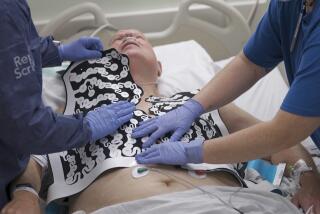Success in treating heart failure
- Share via
Helen Moriarty’s heart valve defect was discovered when she was 3. All her life it has kept her from heavy exertion. Three years ago, she began feeling drained of energy but didn’t immediately suspect her heart.
“I just felt I was working a lot and overstressed and everything,” said the 39-year-old woman, a resident of Middletown, Conn. But a checkup showed a drop in her heart’s pumping power caused by the flawed valve.
Surgeons replaced the troublesome valve and now, thanks to the surgery and drugs that help optimize her heart’s beats, she feels pretty normal these days.
“I got a lot of energy back,” she said, adding that she feels more like herself than she has in years.
Despite its grim name, heart failure can be treated successfully, which is good news to the roughly 5 million Americans who have it. Over the next two decades, as the population ages, that number is expected to double. Although it is mainly a disease of the elderly, younger people also experience it.
Over the last two decades, medical science has added years of high-quality life for people who suffer from this illness. These days, it is more likely to be caught in its early stages when drugs, surgery or implanted pacemakers can stabilize and, in many cases, improve cardiac output.
What’s confusing about the label is that, during heart failure, the heart doesn’t crash all at once.
Physicians have long discussed changing the name to something less dire, says Cheryl Yano, executive director of the Heart Failure Society of America. The condition was once universally called congestive heart failure, referring to the late stage of the illness, when fluid collects in the body. Now that the congestion can be controlled, the illness is called simply heart failure or chronic heart failure.
Heart failure occurs when the heart’s pumping power is diminished. More than half of heart failure cases result from heart attacks that leave heart muscles scarred and weak. High blood pressure, which overtaxes the heart, is also a major cause, as are diabetes, coronary artery disease, infection and mechanical defects. The result is the buildup of fluid in the lungs and legs, which can lead to respiratory and mobility problems. The poor blood flow leads to a decline in endurance. Death can come gradually or from a sudden disruption of the heart’s electrical system.
Although doctors are better at spotting heart failure early, patients often neglect to mention the early stage symptoms -- especially shortness of breath when performing normal activities -- to their physicians, said Dr. Rick Soucier, medical director of the heart failure society and director of the cardiac intensive care unit at St. Francis Hospital and Medical Center in Hartford, Conn.
“It’s something they come to a doctor about, but usually later than they probably should,” he said. “There is a lot we can do” after early detection.
Drug therapy, which has become increasingly effective in the last two decades, focuses on breaking several vicious cycles that are set in motion when the heart muscle is weakened.
The body responds to half-hearted pumping by attempting to soup up the heart with adrenaline and other hormones as well as by retaining more fluid. Both responses make heart failure worse, according to Soucier. “You’re whipping a horse that’s tired,” he said.
Drugs developed in the last two decades that have greatly improved the outlook for patients include ACE (angiotensin-converting enzyme) inhibitors, which protect the surviving heart cells, and beta-blockers, which blunt the toxic effect of adrenaline on the heart. One new drug, epleronone, improves the prospects for people with heart failure after a heart attack. Several older drugs are still in use, including the diuretic spironolactone, which has recently proved to be particularly helpful in heart failure patients. Such underlying conditions as high blood pressure and high cholesterol also must be treated.
Surgery can help those with mechanical defects. For those whose hearts are weakened by out-of-sync electrical signals, new kinds of pacemakers can restore the heart’s normal electrical pattern and increase the force of heartbeats. Many patients with heart failure are at risk for sudden cardiac death. An implanted defibrillator can be used to help prevent this. In most cases, a device is implanted that both resynchronizes the heart and defibrillates.
Dr. Christopher Clyne, director of interventional electrophysiology at Hartford Hospital, said many of the perhaps 10% of heart failure patients who might be helped by these devices would feel better almost instantly, but it was too early to tell whether these gadgets would extend the patients’ lives.
Mechanical heart-assist devices, which are used short-term (typically for six to 12 months) to assist patients waiting for heart transplants, could become permanent implants in people with critically weakened hearts.
Dr. Stuart Katz, director of the heart failure and transplant program at Yale-New Haven (Conn.) Hospital, said that such devices offered promise, especially given that too few hearts are available for transplants.
Talk of a cure is premature, but scientists also are studying the possibility that implanted stem cells will be able to regenerate injured heart muscle cells. Further off is the prospect of programming stem cells in the patient’s own bone marrow to find and repair damaged heart tissue.
Despite the promise of new treatments, Katz said, it’s better to avoid heart failure by preventing coronary heart disease and high blood pressure. “If people do their best to really try to get these problems treated, they will greatly reduce their risk of future heart attack and developing heart failure.”
*
Garret Condon writes for the Hartford Courant, a Tribune company.





